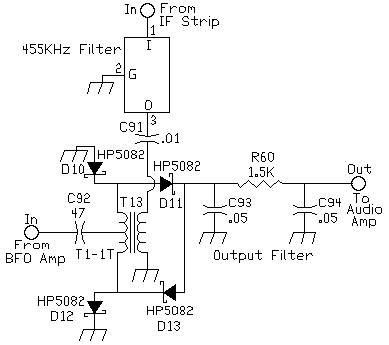Hi! I'm currently building a shortwave SSB receiver. The RF part works fine, so now I'm working on the 455KHz IF side of things.
Here's the 'block diagram'
->[IF filter]->[IF amp]->(prod. det.)->[AF AMP]
î
[BFO]
Receiver works pretty good for about a minute, then the BFO dies, output simply flatlines, and of course, nothing is received then.
I'm at a complete loss as to what could cause this. Has anyone experienced anything like it? Any common causes?
Attached is my schematic. The output frequency is a bit high, so I've tried to pull it a bit more than shown here. 20 nf across the variable cap or so.
Transistor's just a standard BC548
The bfo is fed directly to a product detector made from a 10-turn toroidal transformer and some diodes, the one shown here:

Any insight into the world of IF would be greatly appreciated!
thanks!